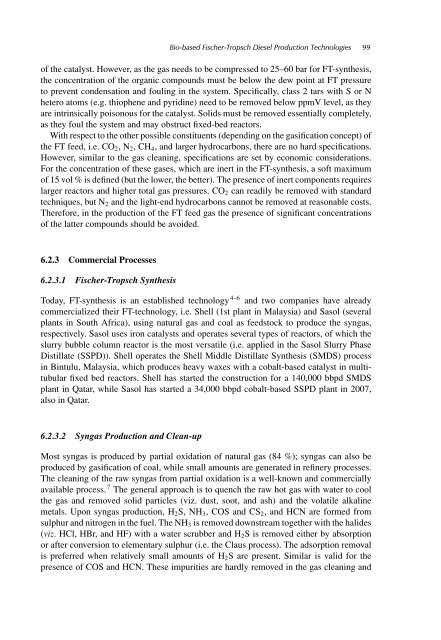Biofuels in Perspective
Biofuels in Perspective
Biofuels in Perspective
You also want an ePaper? Increase the reach of your titles
YUMPU automatically turns print PDFs into web optimized ePapers that Google loves.
Bio-based Fischer-Tropsch Diesel Production Technologies 99<br />
of the catalyst. However, as the gas needs to be compressed to 25–60 bar for FT-synthesis,<br />
the concentration of the organic compounds must be below the dew po<strong>in</strong>t at FT pressure<br />
to prevent condensation and foul<strong>in</strong>g <strong>in</strong> the system. Specifically, class 2 tars with S or N<br />
hetero atoms (e.g. thiophene and pyrid<strong>in</strong>e) need to be removed below ppmV level, as they<br />
are <strong>in</strong>tr<strong>in</strong>sically poisonous for the catalyst. Solids must be removed essentially completely,<br />
as they foul the system and may obstruct fixed-bed reactors.<br />
With respect to the other possible constituents (depend<strong>in</strong>g on the gasification concept) of<br />
the FT feed, i.e. CO2, N2, CH4, and larger hydrocarbons, there are no hard specifications.<br />
However, similar to the gas clean<strong>in</strong>g, specifications are set by economic considerations.<br />
For the concentration of these gases, which are <strong>in</strong>ert <strong>in</strong> the FT-synthesis, a soft maximum<br />
of 15 vol % is def<strong>in</strong>ed (but the lower, the better). The presence of <strong>in</strong>ert components requires<br />
larger reactors and higher total gas pressures. CO2 can readily be removed with standard<br />
techniques, but N2 and the light-end hydrocarbons cannot be removed at reasonable costs.<br />
Therefore, <strong>in</strong> the production of the FT feed gas the presence of significant concentrations<br />
of the latter compounds should be avoided.<br />
6.2.3 Commercial Processes<br />
6.2.3.1 Fischer-Tropsch Synthesis<br />
Today, FT-synthesis is an established technology 4–6 and two companies have already<br />
commercialized their FT-technology, i.e. Shell (1st plant <strong>in</strong> Malaysia) and Sasol (several<br />
plants <strong>in</strong> South Africa), us<strong>in</strong>g natural gas and coal as feedstock to produce the syngas,<br />
respectively. Sasol uses iron catalysts and operates several types of reactors, of which the<br />
slurry bubble column reactor is the most versatile (i.e. applied <strong>in</strong> the Sasol Slurry Phase<br />
Distillate (SSPD)). Shell operates the Shell Middle Distillate Synthesis (SMDS) process<br />
<strong>in</strong> B<strong>in</strong>tulu, Malaysia, which produces heavy waxes with a cobalt-based catalyst <strong>in</strong> multitubular<br />
fixed bed reactors. Shell has started the construction for a 140,000 bbpd SMDS<br />
plant <strong>in</strong> Qatar, while Sasol has started a 34,000 bbpd cobalt-based SSPD plant <strong>in</strong> 2007,<br />
also <strong>in</strong> Qatar.<br />
6.2.3.2 Syngas Production and Clean-up<br />
Most syngas is produced by partial oxidation of natural gas (84 %); syngas can also be<br />
produced by gasification of coal, while small amounts are generated <strong>in</strong> ref<strong>in</strong>ery processes.<br />
The clean<strong>in</strong>g of the raw syngas from partial oxidation is a well-known and commercially<br />
available process. 7 The general approach is to quench the raw hot gas with water to cool<br />
the gas and removed solid particles (viz. dust, soot, and ash) and the volatile alkal<strong>in</strong>e<br />
metals. Upon syngas production, H2S, NH3, COS and CS2, and HCN are formed from<br />
sulphur and nitrogen <strong>in</strong> the fuel. The NH3 is removed downstream together with the halides<br />
(viz. HCl, HBr, and HF) with a water scrubber and H2S is removed either by absorption<br />
or after conversion to elementary sulphur (i.e. the Claus process). The adsorption removal<br />
is preferred when relatively small amounts of H2S are present. Similar is valid for the<br />
presence of COS and HCN. These impurities are hardly removed <strong>in</strong> the gas clean<strong>in</strong>g and








